Cave Without a Name
Century Cave - Century Caverns
Useful Information
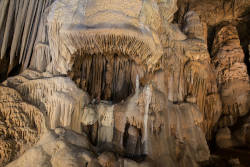
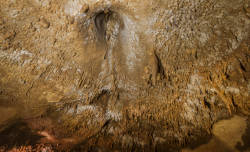
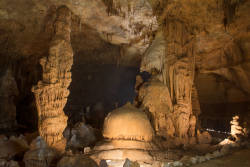
| Location: |
Near Boerne, TX.
I 10 to Boerne, in the city center take County Route 474 northeast about 10 km, right on Kreutzberg Rd. 8 km.
(29.8863391, -98.6174334) |
| Open: |
Memorial Day to Labor Day daily 9-18, last tour 17. Labor Day to Memorial Day daily 10-17, last tour 16. Tours hourly on the full hour. [2021] |
| Fee: |
Adults USD 20, Children (6-12) USD 10, Children (0-5) free, Military USD 18, Seniors USD 18. Groups (12+): Adults USD 15, Children (5-12) USD 8.25. [2021] |
| Classification: |
 Karst Cave
Cretaceous limestone. Karst Cave
Cretaceous limestone.
|
| Light: |
 Incandescent Incandescent
|
| Dimension: | L=4,313 m, VR=25 m, A=375 m asl, T=18 °C. |
| Guided tours: | L=400 m, VR=25 m, ST=126, D=60 min. |
| Photography: | Pictures are encouraged. |
| Accessibility: | no |
| Bibliography: | Brochures available from the Chamber of Commerce, Boerne, TX. |
| Address: |
Cave Without a Name, 325 Kreutzberg Rd., Boerne, TX 78006, Tel: +1-830-537-4212. E-mail: |
| As far as we know this information was accurate when it was published (see years in brackets), but may have changed since then. Please check rates and details directly with the companies in question if you need more recent info. |
|
History
| 1935 | discovered by three farm children. |
| 1939 | opened to the public. |
| 1940 | named Cave Without a Name. |
| 1974 | intensive cave exploration. |
| 2002 | road to the cave improved. |
| 30-APR-2007 | Thomas Summers III died in nearby Dead Man’s Cave. |
| FEB-2009 | declared a National Natural Landmark by the National Park Service. |
| 2010 | additional attrations added to the cave. |
Description
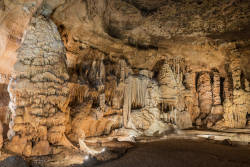
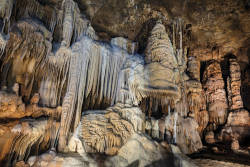
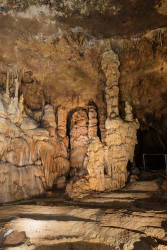
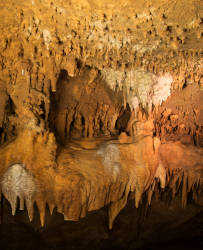
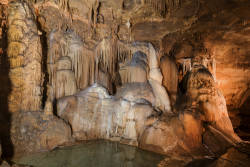
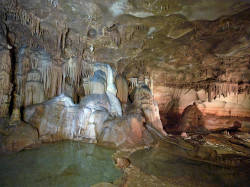
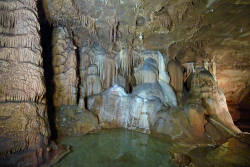
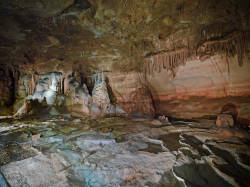
The Cave Without a Name was named such, because in a state wide contest in 1940, a little boy remarked that the cave was too beautiful to give it a name. The cave is well decorated and definitely worth a visit. Many of the formations show an extraordinary bright white. Part of the reason the cave deposits are so translucent is because of the purity of the limestone of which they are formed.
The cave had a natural entrance for many tens of thousands of years. Inside numerous prehistoric animal remains were discovered. But it seems it was not known to the American natives, and it was actually discovered when a farm animal became trapped in the small sinkhole opening. The exact whereabouts are unknown, and the cave was soon forgotten again. But during the era of Prohibition someone remembered the cave and a small moonshine distillery was installed in the uppermost cavern. Obviously an activity which is again not documented at all. In 1935 it was discovered for the third time by three local farm children who actually explored the cave. They are believed to be the first who actually entered the main chambers of the cave.
The owner of the ground at this time, Jim Horn, decided to open it as a commercial venture. He built a stairwell with 126 steps descending 27 m to the main level of the cave. But the cave actually had no name. It seems he held a state-wide contest in 1940 to give the cave a name, most likely a marketing stunt. The young boy who suggested that the cave "was too beautiful to have a name", received the 250 dollar cash prize awarded.
The cave was purchased by Eugene Ebell, and he renamed the cave Century Caverns in the late 1950s However, the locals were quite unhappy with the new name and finally he caved and changed the name back to Cave Without A Name. Still, on some road maps it is listed as Century Cave.
A continuing drought in the San Antonio area until 2002 threatened the cave, according to the owner Thomas Summers II. But the water situation changed completely in July 2002, when a huge flood took place. Thomas Summers II is the third and current owner of the cave. When his son Thomas Summers III became manager of the cave he improved the show cave. As the cave had been reached by a 8 km rocky road, the visitation was very poor. In 2002 the road was paved except for the last 1,600 m, a few years later the rest of the road was improved. Thomas Summers III died on 30-APR-2007 in nearby Dead Man’s Cave, which is also on his property. Together with Brent Holbert he had gone into Dead Man’s Cave to investigate why water from recent rains was not draining from Cave Without a Name. They swam into the cave where at times were only 5 cm of breathing room. Brent Holbert finally suggested to return, because this was quite dangerous. But Summers chose to go a few yards further and after a while Holbert heard sounds of distress. He did the thing to exit the cave to call for help. A few hours later cavers experienced in cave diving recovered Summers body.
Since 2010 the cave offer numerous other activities, like hiking trails, a scavenger hunt, gem panning, geocaches, picnic tables, camp ground, and a sculpture garden. The gift shop sells a large selection of rocks, minerals, and fossils.
The developed part of the cave is about 400 m long and has six large chambers. One of the biggest is Queen’s Throne Room with three large solution domes on the ceiling. The result is a great natural acoustics and so it hosts 8-12 concerts each year, with attendances of up to 200 people. The concerts have a wide range, from vocals, native American flute music, to Tibetan singing bowls. Most speleothems are, except for their colour, quite common, stalactites, stalagmites, columns, and draperies. A set of 5.8 m long draperies are referred to by the cave guides as "Texas-sized cave bacon". Less common are numerous helictites and the 15 m long set of rimstone dams beneath the natural pool.
During winter the cave is used by some 120 eastern pipistrelle bats for hibernation. The Kendall County salamander is an endemic troglobiont which can be found only in this cave and nearby Cascade Caverns.
The pictures on this page are from Carol M. Highsmith, who made an impressive series of rural America. She photographs the entire American vista, including landscapes, architecture, urban and rural life, and people in their work environments, in all fifty U.S. states as a record of the early 21st century. Highsmith donated her life’s work of more than 100,000 images, royalty-free and in highest possible quality, to the Library of Congress, which established a free one-person archive.

|
| Cave Without a Name Gallery |
 Member of the International Show Caves Association (ISCA)
Member of the International Show Caves Association (ISCA) Search DuckDuckGo for "Cave Without a Name"
Search DuckDuckGo for "Cave Without a Name" Google Earth Placemark
Google Earth Placemark OpenStreetMap
OpenStreetMap Cave Without a Name - Wikipedia (visited: 30-MAY-2021)
Cave Without a Name - Wikipedia (visited: 30-MAY-2021) Cave Without a Name, official website (visited: 30-MAY-2021)
Cave Without a Name, official website (visited: 30-MAY-2021) Index
Index Topics
Topics Hierarchical
Hierarchical Countries
Countries Maps
Maps